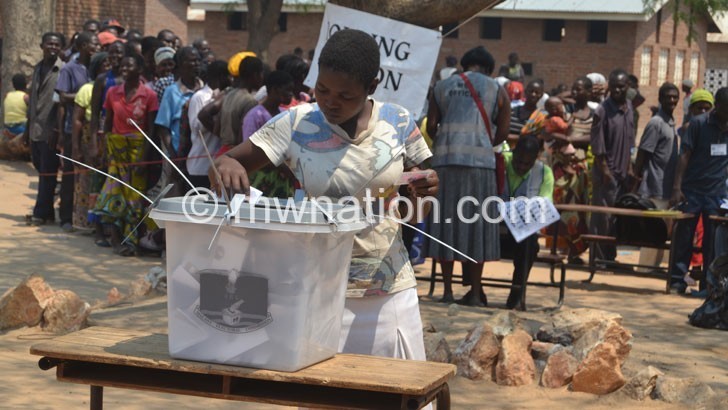Voter apathy highest in Central Region
The Central Region has registered the second highest voter apathy in the just-ended May 21 Tripartite Elections.
At 26 percent, civic education experts have attributed this to lack of civic education and relocation of seasonal tobacco workers.

The North had the least voter apathy rate, with only 22 percent of registered voters not turning up to vote, according to MEC figures.
In both the Centre and South, 800 000 people did not vote out of the registered 2.9 million and 3 million respectively.
But the Centre’s higher apathy is a result of the region having had fewer registered voters than the South.
This year’s voting pattern is, however, an improvement on the 2014 trend when the Centre registered 31 percent voter apathy against 30 percent for the South. The North was constant at 22, our analysis has shown.
National Initiative for Civic Education (Nice) Trust executive director Ollen Mwalubunju attributed the higher voter apathy in the Central Region to seasonal workers migration.
The Centre, being the heart of tobacco growing, attracts workers between October and March. When tobacco marketing season kicks in, tobacco tenants usually relocate to other areas after selling their crops.
Mwalubunju also observes that some of these people did not get transfers to enable them to vote wherever they moved to.
As for people in urban areas, he said, are hard to reach with voter education.
“While they are interested in national issues, they do not want to contribute to the democratic process, hence the lower voter turnout in urban areas,’’ said Mwalubunju, adding that Nice Trust deployed civic educators in all parts of the country to mobilise voters.
However, he suggested that there is need to work with government to introduce civic education to build capacity.
On his part, National Elections Systems Trust (Nest) executive director Unandi Banda observed that higher voter apathy this year was common in areas where voter registration was first launched.
He said: “Voter registration started in the Central Region, which was more of a training ground and the registration process was fraught with many errors. This disenfranchised some people. As MEC moved to other regions, it perfected the system and registered fewer errors.”
Banda also said some people failed to vote because poorly-trained polling and constituency tally officers were not able to trace their missing names
Among those whose names went missing are UTM president Saulos Chilima, whose name was transferred from St Thomas in Lilongwe to Chikweo centre in Chizumulu Island in Likoma district and Juliana Lunguzi a parliamentary candidate in Dedza East had to trace her name to another centre other than the one she was registered. Both Chilima and Lunguzi were assisted and managed to vote because of their prominence in society.
But it is not known how many people failed to vote because of the unsolicited transfers.
“The transfers happened to several people,” Lunguzi said, adding that she did not follow up because she managed to vote within the same constituency.
But MEC said it was not aware of any other unauthorised transfer apart from those of Chilima and Lunguzi.
Shift in voting trend
But the voting trend shows a shift for Blantyre and Lilongwe—the two most populous districts with the highest registered voters—during the past two elections.
In 2014, Lilongwe had 1 012 963 registered voters out of whom 744 464 people, or 69 percent cast their vote. But this year, the turn out for Lilongwe decreased by 3 percent to 66 percent. On the other hand, the turnout for Blantyre which had 498 441 registered voters this year, increased by 13 percent points from 62 in 2014 to 75 percent in 2019.
At national level, this year’s voter turnout was higher by one percentage point at 74 percent from 73 percent in the 2014 elections.
At district level, voter turnout shows that Ntchisi—with 228 295 registered voters—had the highest voter apathy after only 96 310 people, representing 57.81 percent turned out to vote. This is against 24.61 percent voter apathy in 2014. Thyolo District had the second highest voter apathy of 37 percent, an increase from 26 percent in 2014. Voter apathy in a majority of the districts ranged between 20 and 30 percent.
On the other hand, Mchinji had the highest turnout with 222 404 out of the 241 943 registered voters turning up to vote representing a 92 percent turnout[u6] . With 84 percent of the 6 000 registered voters casting their vote in Likoma, the archipelago had the second highest voter turnout.
MEC said it is fully satisfied with the voter education they conducted, saying that was why the voter turnout was higher at 74 percent this year from 71 percent in 2014.
“This is despite the fact that many civil society organizations (CSOs) that were accredited to conduct voter education were not on the ground as they did not have funding,” MEC spokesperson Sangwani Mwafulirwa said in an e-mail response.
MEC statistics show that voter turn-out improved to 78 percent in 2009 before slowing down to 71 percent in the 2014 Tripartite Elections.
Fewer people (6.8million) registered as voters this year compared to the 7.5 million that registered in 2014 despite more youths reaching the voting age and the country’s population growing at 2.9 percent.





